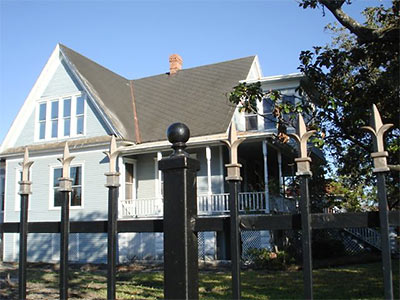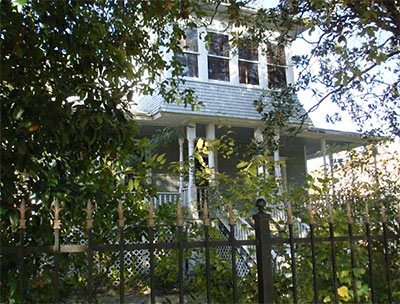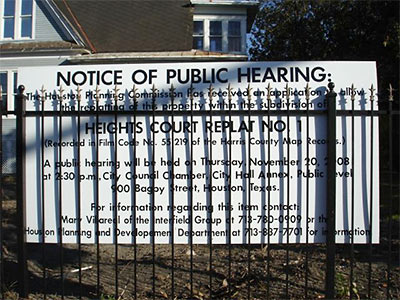
A Heights-area reader alarmed by the “Notice of Public Hearing” sign that appeared in front of the 100-plus-year-old converted home at the northeast northwest corner of Heights Blvd. and 11th St. has done some sleuthing and sends Swamplot a report:
No, the 1903 Victorian at 1101 Heights Blvd. won’t be torn down . . . the owner has received approval from the historic commission to move the building one lot to the north. And then to jack it up a few more feet, so cars can be parked underneath. Why hadn’t the Victorians thought of that?
Why the need for parking? To accommodate the brand-new strip center the developer wants to slide in between the new location for the home and the corner, facing 11th St. On the corner itself: Parking.
One observer who’s seen the plans says the house will end up “awfully close” to the back of the strip center. The developer apparently has promised to “restore” the home, though it may be leased out as office space. The project is scheduled to go before the planning commission a week from this Thursday: November 20th.
More photos from the scene:
***








I don’t think there is much to complain about. As much as some people like to be down on developers for bulldozing an old home, at least this one found a away to save it and incorporate it into the future use of the property.
Strip mall space is in high demand on that block – one only need see how fast the adjacent project on Yale rented out!
Awesome! This is so Houston! Take what everybody loves about our city’s most unique, beautiful neighborhoods, dismantle, warp, and mutate those characteristics, and throw in a generic strip mall. I can’t wait until the Heights looks like every far-flung suburban craphole out there and I no longer have any reason or desire to visit the area. Only then will the anomaly that is the Heights properly fit in this great, wonderful parking lot of a city.
I love how people claim that the heights is something special and different than the suburbs!
The heights is part of the original suburbs. It was planned by developers that came in and clear cut a forest. Then filled in natural streams with not only dirt, but land fill (trash). Then they laid out streets in a generic pattern and put up spec homes that mostly looked the same (for some reason they are historic now).
That is so much different than the modern suburbs! Thanks for making it clear.
KGB-
If I’m in the mood for a quaint coffee shop, I can walk there in 5 minutes. If I’m in the mood for live music, I can walk there in 5 minutes. If I want to sit out on a patio with some friends for a beer, I only have a 5 minute walk. Patio cafes? 5 minutes. Fancy eatery? 5 minutes. Parks? 5 minutes. Art Galleries? Oh, now we’re up to a 10 minute walk.
Please advise which Houston suburb I can do this in without compromising my 5 minute drive to work or my 5 minute drive to the Theatre District as I have seasons tix to TUTS. thanks so much.
Stip centers on Yale, fine…on Heights Blvd. Please NO!
That would be ruining the very thing that makes it attractive.
Jeff,
If 5 minutes to walk or drive is your preference for choosing a neighborhood, then that is your decision.
That doesn’t determine if a style of development or subdivision is better than the other. Many suburbanites don’t use these criteria to choose their dwelling. Are they wrong for that? What if they hate walking or having commercial availability right by there house? Would if they only make a monthly trips to a store so they need a car to carry everything?
What I don’t get about the walkable neighborhoods crowd is that even in these neighborhoods most people still use a car to do there trips anyway. The people that have the intention of walking more with use it and the people that don’t won’t. The expenditures to encourage walking don’t work to convert people. The people that will choose that mode were pre-determined to do so.
Also, Heights Blvd already has several strip centers and apartment complexes too. At least the new one will have to abide by the tree ordinances and you don’t have to worry about a large shopping center since too many properties would have to be amalgamated.
There are just some areas that are more scenic than others. They should be preserved. There are some areas with historic value. It is their very value that brings the predatory type of investors in. They destroy the value that attracted them in the first place. Why not adapt to the area and develop accordingly.
If they are so historic to you or to the neighborhood, then you and/or the neighborhood should by it and preserve it. It’s a very simple solution.
If I happen to buy a lot with a 100 year old home that I don’t like but like the neighborhood, why shouldn’t I be able to tear it down? It’s my property.
In Timbergrove Manor, the 11th street park was saved by concerned citizens raising money and getting the investment of a bank involved. They made a good case. HISD that owned it also got the market value of the property since they didn’t want it anymore. This same premise can be used to save “historic” buildings.
As usual, Kyle gets it. Because people live in the Heights, they think that special rules should apply to them…. because, because, well, because they want them to dammit! If it’s so damn important to you to be able to make sure all of these things stay just as you believe they are now, get involved and make it happen. Just don’t expect some governmental body to step in an impose land use limitations on other people to make their private property conform to what you perceive they should do with their property.
The corner of 11th and Heights is a very busy intersection. It makes alot of sense to have some type of commercial property on the corner. Going to the extreme expense of moving and elevating an historic dwelling to the lot next door is quite an accomodation. In addition, it moves this “valued” structure to a more desireable location. Residential dwellings on busy street corners often end up being undesireable non-owner occupied real estate, contributing to unkept appearing properties and therefore degrading the overall appearance of neighborhoods. While strip centers aren’t exactly prized ancient victorian treasures, if prudently maintained and occupied by successful businesses, they can be an attractive and valuable part of the overall community.
Personally, I’ve lived in the Heights and currently live nearby. I can also walk to nearby venues from my home. I actually am looking forward to the new strip center that will be going up 2 block from my house on a busy street corner that will include a couple of new bars (that naturally the NIMBYS are whining about). It’s all about attracting and maintaining a diverse functional living, entertaining, eating and shopping lifestyle that makes a neighborhood enjoyable. People are different. That’s one of the aspects that makes the Heights, the Heights, as well as my neighbhorood what it is. Cookie cutter does not do it for me. Putting in a small strip center on a busy street corner in the midst of an eclectic older inner city neighborhood doesn’t necessarily equate to cookie cutter either.
Once it is gone, it’s gone. Then you have just a bunch of strip centers that are poorly maintained or secured and the next thing you know, it’s sharpstown.
EMME,
If you don’t want it gone, buy it!
Get some like minded friends to jump in on the purchase. If you and the neighborhood aren’t willing to do that to save it, then you really don’t want to save it.
The demise of beloved Houston neighborhoods serves nobody. Unfortunately, neighborhoods do have the potential for irreversible decline if enough poor decisions are made by individuals. This one project won’t destroy the Heights, but I’m skeptical that anybody truly believes that building parking lots along Heights Boulevard would improve this historic community.
Why don’t people who prefer destroying historic homes and replacing them with faux-historic hippotamuses or even big-box contemporary homes settle in the suburbs? Seems to me the land would be cheaper and they would be more comfortable among their own kind.
The one frequent commenter has hit on the overwhelming fact that ‘he who has the gold makes the rules.’ He/she does present that as a positive thing, unfortunately.
Unquestionably, the home values in the consistent, protected Heights areas such as Norhill and Woodland Heights exceed the values of homes on the patchwork blocks. The recent historically-designated blocks continue to lose inventory, so the jury is still out.
The property rights issue is phony. One owner’s rights begin only where those of his or her neighbor’s end. Dangerous piles of trash or construction that floods a neighbor’s yard are two clear examples of the limited rights of landowners.
Let the big brains with the big money rail about their ‘rights’. Wrong is wrong. It is a matter of respect and reverence for our history, and the values and contributions of the people who preceded us that impels us to work to maintain our neighborhoods.
DarbyMom asks: “Why don’t people who prefer destroying historic homes and replacing them with faux-historic hippotamuses or even big-box contemporary homes settle in the suburbs?”
Because suburbs are either too far away from places to work and play, aren’t as walkable, aren’t as safe, are chock full of Republicans and Christians, or because comparable neighborhoods in the Bellaire or West U areas are too expensive. There are many people that can appreciate the qualities of the greater Heights area and still not want to deal with the idiosyncracies or the smaller size of typical older homes.
Gawd, the obnoxious stink of liberal elitism really wafts up to the surface on some of these threads. The elitist liberal mantra has a monopoly on real estate inside the loop according to some of you. If you are republican, or christian, or not a NIMBY we DON’T WANT YOU AROUND HERE. Sometimes you people should really listen and/or think about some of the tripe that comes out of your mouths and/or computers before you send it out of said mouths/computers.
Until people living in these older so-called historic neighborhoods start organizing themselves (oooh let’s become a community organizer) and developing/implementing plans for either deed restrictions or some sort of zoning, property rights are going to be the name of the game. One of the things that makes Houston, Houston is no zoning. If you don’t live in a deed restricted neighborhood, you take the chances that something you don’t expect will be built near you. People are different. Not everyone wants to live in a little renovated bungalow. I’ve lived in a renovated home built in 1919 in the West End. I don’t want that anymore. So I moved to a close-in subdivision and later bought a new home, inside the loop. I also don’t want to live far from the city’s center. Many people feel that way. These people also have the right to live pretty much where they want to if they can afford it.
One of the things that ruins and distorts zonings’ effectiveness are some of the attitudes displayed on this thread by people that get into a position of authority on municipal zoning boards. Freedom of speech and property rights are wonderful…. as long as they agree with THE WAY I THINK! Right. I can’t remember how many cranky, obnoxious, power hungry little zoning nazis people I know have had to do battle with over rediculous land use obstacles.
It is so like the stereotypical liberal elitist to know best and to tell everyone else where to live, how to live, what they can think, what they can watch, what they can listen to, etc. Give me a freakin break.
Woodland Heights and Norhill are examples of Heights neighborhoods that have property owners who’ve come together and maintained the integrity of the neighborhood the right way. The price of property in the rest of the Heights will continue to escalate in value even though there are no deed restrictions or zoning. The individual property owners, however will be the ones who determine just what is built or renovated on their own property (within COH land use guidelines), not some doe eyed idealist hell bent on requiring everyone else to do what they want.
There are good developers and bad ones. The high price of inner loop property generally dictates that upper scale construction will take place in those inner city areas….not always, but usually. Sometimes, the most effective use of a busy street corner is a little strip center…. even if it’s in an older historic neighborhood.
Oh, and by the way, I’ll bet you that crime in the Heights is a helluvalot worse than most decent suburban neighborhoods.
CK, turn down the AM radio there buddy, and consider.. many people came into town to escape the tyranny of the dollar, the tyranny that has created the crappiest-common-denominator train wreck pinky-beige excuse of a built environment way out there in the burbs. Many of us grew up with that crap, isolated and bored, and came here into town for something different. The suburbs show that letting money do what it will is totally flawed in terms of building a city worth living in. The way people drive out there is just one expression of the denial of the fact that we all impact each other by our choices. There really is no such thing as individualism, only people who are in denial. So when people who are good at exploiting situations and people- that’s why they have the gold, not because they are decent or kind or well-intentioned- when those people start tearing one of the few non pinkish-beige places around so they can get more of the green stuff.. it’s not some fantasy staw-man liberal elite tripe to say that this is pretty fucked up, and it should stop. Go build strip malls in Katy, assholes. Not that the Heights isn’t already pretty much lost to those who worship money above all else.
PS – I should give the developer some points for preserving this house… maybe this one development won’t be done fast and cheap for once?
This is what I love about the Heights. When one speaks of the Heights, no matter from which side of the argument, there is always passion.
Carlos, I hate to burst your bubble, but the Houston Heights was developed as a commuter suburb before municipal land use planning was even an option. It actually started out as it’s own municipality (akin to how we think of Sugar Land), and some of the uptight old Heights ordinances survive to this day, which is why it is considered ‘dry’.
.
At it’s core, the Heights as it exists today is nothing but the very same for-profit built environment that you decry, marketed to the well-off squares of its day. The only meaningful difference is that it was developed to suit technologies, consumer preferences and market conditions of a bygone era.
.
For the record, I agree that there’s better quality of life in the Heights than in Sugar Land (though I may think differently if I were responsible for a school-age child or worked in Sugar Land), but to say that it is somehow in spite of the almighty dollar is absurd. It’s because of it. The Heights decayed until the 90’s because of it; the Heights has risen from the ashes and enjoyed renewed popularity because of it; and for better or worse, the Heights is in the process of being tranformed into something more shiny and modern because of it. The Dollar giveth and the Dollar taketh away…to give to someone else who values it more (but differently).
.
If you yearn for your perception of the glory days of the Heights’ past, you would be well advised to move to Eastwood or 2nd Ward. We have fewer Hummer H2s here…at least for the time being.